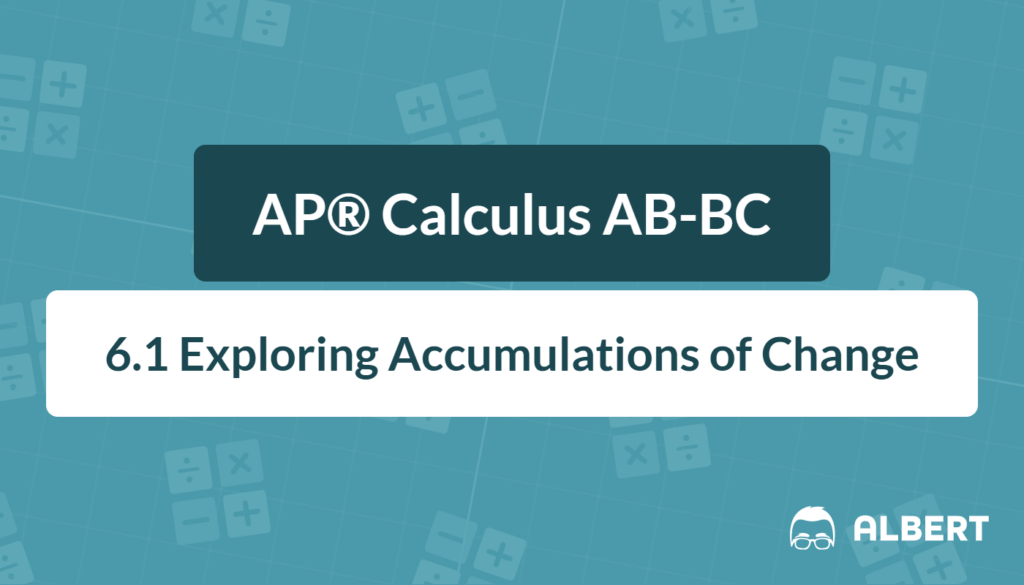In AP® Calculus, “accumulation” is measured by the area under a rate curve. This lesson explains how the College Board learning targets CHA-4.A.1–4 bring the idea to life. The keyword “6.1 accumulation of change” appears often, because it is the exact topic in the Course Framework.
What We Review
Why Accumulation Matters
Rate of Change vs. Total Change
A rate of change is instantaneous, like the speed shown on a car’s speedometer. However, drivers care about total distance too. Therefore, Calculus links:
- instantaneous rate → derivative
- accumulated total → area under the derivative graph
Visual Preview: The Area Under a Rate Curve
Picture a graph where time is on the x-axis and faucet flow (liters / minute) is on the y-axis. The region trapped between the curve and the x-axis shows how much water has entered. Because area is easy to “see,” it becomes a natural bridge from rate to total.
Analogy: A water tank gains one “sheet” of water for each thin rectangle of height (flow) and width (time). Summing every sheet gives the accumulated volume.
Area Gives Accumulated Change
Concept, Plain Language
If the rate of change is always positive, the accumulated change equals the geometric area under the rate graph. No calculus symbols are required yet; only familiar shapes matter.
Example 1 – Linear Flow Rate
A faucet opens and the flow rate increases linearly from 0 L/min to 4 L/min in 4 minutes.
Step 1. Sketch
Draw a right triangle with base 4 on the x-axis and height 4 on the y-axis.
Step 2. Compute Area
\text{Area} = \tfrac{1}{2}\times\text{base}\times\text{height} = \tfrac12(4)(4) = 8Step 3. Interpret
Therefore, 8 liters of water enter the tub in 4 minutes.
Using Geometry to Evaluate Accumulation
Common Shapes in AP® Calculus
Students often meet:
- rectangles
- triangles
- trapezoids
- semicircles
Knowing their areas short-cuts many exam questions.
Example 2 – Piecewise-Constant Velocity
A toy car moves with the velocity graph below:
- 0–2 s: 3 m/s (rectangle)
- 2–5 s: drops linearly to 0 m/s (triangle)
Step 1. Rectangular Area
A_1 = (2\ \text{s})(3\ \text{m/s}) = 6\ \text{m}Step 2. Triangular Area
Base = 3 s, height = 3 m/s, so
A_2 = \tfrac12(3)(3) = 4.5\ \text{m}Step 3. Total Distance
6 + 4.5 = 10.5\ \text{m}Hence, the car travels 10.5 meters in 5 seconds.
Positive vs. Negative Accumulation
Sign Analysis on a Graph
Whenever the rate graph lies above the x-axis, area counts as positive. However, if the graph dips below, the area is negative, indicating reversal or loss. Therefore, the net area equals positive area minus negative area.
Example 3 – Changing Direction
A velocity function crosses the x-axis at t = 3 s.
- 0–3 s: rectangle, 2 m/s, gives +6 m
- 3–5 s: rectangle, –1 m/s, gives –2 m
Net displacement:
6 - 2 = 4\ \text{m}Although the car moved backward after 3 seconds, it still ends 4 meters forward from the start.
Keeping Track of Units
Unit Multiplication Rule
(rate units) × (time units) = (total change units).
Therefore, always multiply, never add, the labels.
Example 4 – Revenue Over a Week
A small store earns money at a constant rate of $500 per day for 7 days.
Step 1. Identify Units
Rate = $ / day, time = day.
Step 2. Compute
\$500\ \text{/day} \times 7\ \text{days} = \$3{,}500The accumulated revenue equals $3,500, and the day units cancel as expected.
Putting It All Together
Mixed Graph Interpretation
Real graphs combine multiple shapes and sign changes. Therefore, break the region into digestible pieces, assign signs, add positives, subtract negatives, then attach proper units.
Example 5 – Comprehensive “Water Tank” Graph
Suppose the tank’s inflow rate, r(t), is graphed over 8 minutes:
- 0–2 min: rectangle, 1 L/min
- 2–5 min: triangle rising to 5 L/min
- 5–6 min: rectangle below x-axis, –2 L/min (leak!)
- 6–8 min: trapezoid averaging 3 L/min
Step-by-step solution:
- Rectangle: (2)(1)=2(1)=2 L
- Triangle: \tfrac12(3)(5)=7.5 L
- Negative rectangle: (1)(-2)=-2 L
- Trapezoid: average height \tfrac{(5+1)}{2}=3 L/min, width 2 min, so (3)(2)=6 L
Net accumulation:
2 + 7.5 - 2 + 6 = 13.5\ \text{L}Therefore, 13.5 liters net enter the tank. The example previews how Riemann sums will eventually replace geometry with formal integrals.
Quick Reference Vocabulary Chart
| Term | Short Definition |
| Accumulation of change | The total amount gained or lost over an interval, usually found by area under a rate graph |
| Rate of change | Instantaneous growth or decay per unit, the derivative of a quantity |
| Net area | Positive area minus negative area between graph and x-axis |
| Displacement | Net change in position; signed area under velocity |
| Trapezoid rule | Area approximation using trapezoids, often tested on FRQs |
| Units analysis | Process of ensuring final answers carry correct labels |
Conclusion
The 6.1 accumulation of change topic shows how:
- (CHA-4.A.1) Area models accumulated change.
- (CHA-4.A.2) Simple geometry often replaces calculus.
- (CHA-4.A.3) Positive and negative regions matter for net results.
- (CHA-4.A.4) Units must multiply correctly.
Therefore, mastering graph-based area prepares students for definite integrals, Riemann sums, and all later integral techniques. Next, study those Riemann sums; the pieces will fit perfectly.
Sharpen Your Skills for AP® Calculus AB-BC
Are you preparing for the AP® Calculus exam? We’ve got you covered! Try our review articles designed to help you confidently tackle real-world math problems. You’ll find everything you need to succeed, from quick tips to detailed strategies. Start exploring now!
Need help preparing for your AP® Calculus AB-BC exam?
Albert has hundreds of AP® Calculus AB-BC practice questions, free responses, and an AP® Calculus AB-BC practice test to try out.








